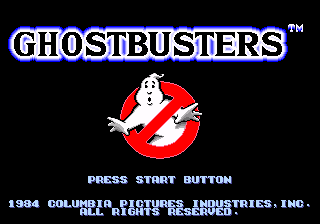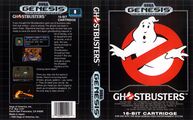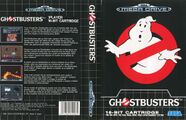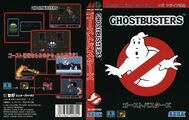Ghostbusters (Mega Drive)
From Sega Retro
This short article is in need of work. You can help Sega Retro by adding to it.
| Ghostbusters | |||||
|---|---|---|---|---|---|
| System(s): Sega Mega Drive | |||||
| Publisher: Sega | |||||
| Developer: Compile, Sega | |||||
| Genre: Action | |||||
|
Ghostbusters (ゴーストバスターズ) is a Sega Mega Drive game developed by Compile (though they are not credited and do not credit themselves on their website, some of the names in the Production Credits are Compile employees) and Sega and released in 1990 by Sega. It is a Mega Drive exclusive — a completely different title from the Master System game with the same name despite both being developed by Compile. It is a platformer which stars the Ghostbusters Peter, Ray and Egon, though for some reason omits Winston.
Gameplay
The gameplay is perhaps most comparable to Contra and Mega Man, although with plenty of quirks and oddities. The player would start by choosing either Peter, Ray, or Egon. Each of the three characters has different health and power attributes. They would remain with this character through their whole gameplay until either game over or game clear.
The plot starts with the Ghostbusters seeking a profit from their business, and then the world map appears. The player can access four of the levels or a shop from which to buy items. The player starts with little money to buy items, though; one must clear levels to get money. Each level has its own pre-set monetary reward, which also reflects their difficulty level; the lowest-rewarding stage is easy, while the highest-rewarding stage is hard.
Once the player selects a level, a dialog appears where the resident explains the haunting conditions. Afterwards, gameplay begins. The player platforms left and right, shooting at enemies, dodging obstacles, and occasionally looking for secrets. In many instances, items from the shop provide helpful functions, such as freezing flames, spread shots, or temporary invincibility.
In many rooms, the player will encounter sub-boss characters, who, once defeated, will turn into ectoplasm and try to escape. In this sequence the player aims his Proton Pack diagonally to try to zap the ghost and suck it into the Ghost Trap which appears on the screen. Succeeding in this task will reap major bonuses for the player.
Bosses are huge monsters that take up large portions of the screen, and have small weak-points like in shmup games. The Stay Puft Marshmallow Man, for example, has his weak point be at his eyes. After defeating each boss, the player receives a Stone Tablet which is used to advance the plot.
After the first four levels are cleared, a new plot revelation happens and the final level is unlocked, upon clearing it the player reaches the end.
Production Credits
- Planner: Okaru.
- Programmer: Ryu Ohmori, Healthy Oyama, Mizutan, Tantan, Jemini Hirono, Kawauso, Com Blue, K.K., K.Koba
- Designer: Doro Pi, Locky P, Sakatsu Rimo
- Sound: Nav.
- Special Thanks: Arishi, Levin, Idaten, Onion
Physical Scans
| 69 | |
|---|---|
| Based on 36 reviews | |
- ↑ 1700 igr dlya Sega, "" (RU; 2001-xx-xx), page 87
- ↑ ACE, "September 1990" (UK; 1990-08-03), page 56
- ↑ Ação Games, "Junho 1991" (BR; 1991-06-19), page 12
- ↑ Beep! MegaDrive, "July 1990" (JP; 1990-06-08), page 16
- ↑ Buzz! Computers (UK) (+0:00)
- ↑ Complete Guide to Consoles, "Volume III" (UK; 1990-08-xx), page 76
- ↑ Complete Guide to Consoles, "Volume IV" (UK; 1990-11-xx), page 30
- ↑ The Complete Guide to Sega, "" (UK; 1991-05-xx), page 47
- ↑ Console XS, "June/July 1992" (UK; 1992-04-23), page 130
- ↑ Cool Gamer, "9" (RU; 2002-10-13), page 92
- ↑ Computer & Video Games, "September 1990" (UK; 1990-08-16), page 92
- ↑ Mean Machines: The Essential Sega Guide, "" (UK; 1993-11-18), page 50
- ↑ Famitsu, "" (JP; 1990-0x-xx), page 1
- ↑ The Games Machine, "September 1990" (UK; 1990-08-xx), page 62
- ↑ Joystick, "Octobre 1990" (FR; 1990-xx-xx), page 107
- ↑ Sega Mega Drive Advanced Gaming, "January 1993" (UK; 199x-xx-xx), page 92
- ↑ Mega Drive Fan, "October 1990" (JP; 1990-09-08), page 79
- ↑ Mega, "June 1993" (UK; 1993-05-20), page 20
- ↑ Mega, "January 1994" (UK; 1993-12-16), page 87
- ↑ Mega Play, "November/December 1990" (US; 1990-xx-xx), page 29
- ↑ MegaTech, "Xmas 1991" (UK; 1991-12-06), page 78
- ↑ MegaTech, "August 1993" (UK; 1993-07-20), page 112
- ↑ Mean Machines, "December 1990" (UK; 1990-12-xx), page 64
- ↑ Mean Machines Sega, "October 1992" (UK; 1992-09-xx), page 139
- ↑ Megazone, "June/July 1991" (AU; 1991-0x-xx), page 25
- ↑ Player One, "Janvier 1991" (FR; 199x-xx-xx), page 53
- ↑ Raze, "April 1991" (UK; 1991-02-28), page 54
- ↑ Sega Power, "May 1991" (UK; 1991-04-04), page 24
- ↑ Sega Power, "October 1991" (UK; 1991-09-05), page 53
- ↑ Sega Pro, "Christmas 1991" (UK; 1991-12-12), page 19
- ↑ Sega Pro, "April 1993" (UK; 1993-03-11), page 65
- ↑ Sega Saturn Magazine, "September 1995" (JP; 1995-08-08), page 87
- ↑ Tilt, "Septembre 1990" (FR; 1990-0x-xx), page 85
- ↑ Tricks 16 bit, "Tricks Sega Gold 800 igr" (RU; 1998-03-20), page 80
- ↑ User, "Fevrouários 1991" (GR; 1991-0x-xx), page 66
- ↑ VideoGames & Computer Entertainment, "June 1990" (US; 1990-0x-xx), page 56



